The daffodils are out, the occasional shaft of spring sunshine illuminates King’s College Chapel, and my timeline is full of pictures of cheerful party activists celebrating the great reception they are getting on Cambridge doorsteps. Yes, it’s local election time again. This year we are choosing one third of our representatives on Cambridge City Council, as the fourteen councillors elected in 2014 reach the end of their terms. In East Chesterton there is a double dose of electoral excitement, as Margery Abbott’s resignation mid-way through her term of office means there are two seats up for grabs.
So here is my now-traditional look at the prospects for the forthcoming local elections in Cambridge. Electoral nostalgia fans can find previous editions here: 2012, 2013, 2014, 2015, 2016, 2017. First of all, let me dispel any sense of drama and excitement about the overall result: Labour will retain control of the City Council this year. However, there will be plenty of drama and excitement in at least some of the wards, and the longer-term picture is a good deal less certain.
Here is a summary of the state of the council before these elections – with 26 seats, Labour had a comfortable majority of ten over all other councillors combined.

However, most of the seats up this year were last contested in 2014, when Labour won an emphatic victory. Consequently Labour have ten seats to defend this time, compared with only four for the Lib Dems. Here is the seat graphic again, this time with hollow blocks showing the seats being contested this year:

So with fifteen seats being contested, and Labour’s majority amongst the other seats standing at only five, couldn’t they lose control of the Council this year? Well, theoretically, yes, but in practice Labour have enough safe seats that it would take a political earthquake to deprive them of control, and even in these turbulent times there is little sign of one. However, losing seats this year would make Labour’s position more precarious next year, when they have a further eight seats to defend. On the other hand, the Lib Dems are far from certain to make gains this year, and face some tricky challenges in wards they are defending.
There were no City Council elections in 2017, as it was the turn of the County Councillors to face the electorate. It was an unusual local election, taking place just a few weeks before the snap General Election, and alongside the vote for the first Mayor of the new Cambridgeshire and Peterborough Combined Authority. Nevertheless, the results in Cambridge vividly illustrate the difference in voting patterns between local and national elections. Here are the 2017 County Council vote shares in Cambridge:
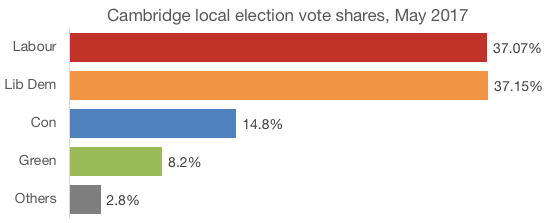
And here is the result of the Cambridge seat in the General Election a few weeks later (on slightly different boundaries):
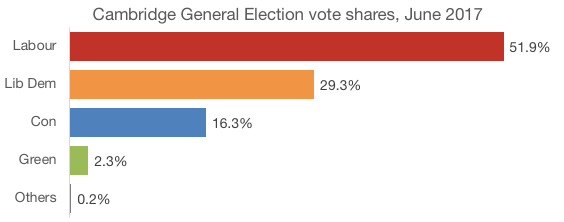
As you can see, Cambridge went from a knife-edge result in the County elections to an emphatic Labour victory in the General Election – at least partly assisted by the collapse in the Green vote. Although Julian Huppert’s vote fell by only 1,676 votes from his 2015 total, Daniel Zeichner’s increased by 10,386. The principal reason for Labour’s General Election victory in Cambridge is that they managed to identify and motivate a large number of voters who had not previously supported them. However, history suggests that they may find it difficult to repeat this in a local election year, so we are likely to see a closer overall picture in this year’s vote.
Let’s have a look at the wards. I’ve previously illustrated each ward with a graph showing the local election results for the last several years. However, boundary changes mean that County Council divisions no longer match City Council wards, so this time I’m only showing the three previous City Council results, in 2014, 2015 and 2016.
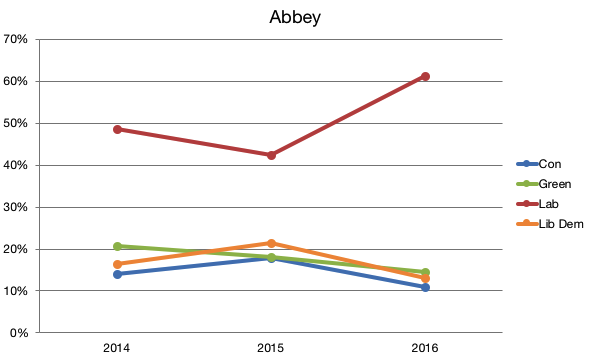
Abbey is the one seat in Cambridge where City and County boundaries still match. Looking at previous City Council results you would think it is pretty safe for Labour, but in the County elections last year Labour got a nasty scare, beating the Lib Dems by just 3%, and only after piling activists onto the streets on polling day to get their vote out. This was partly due to increased Lib Dem activity in Abbey ahead of last year’s General Election, but also due to the energy injected into the Lib Dem campaign by their candidate Nicky Shepard, who is standing again this year. With incumbent Labour councillor Peter Roberts standing down, Labour’s candidate is another Nicky, Nicky Massey. Although this is her first time standing for elected office in Cambridge, she has been involved in a number of campaigns, calling for a new pedestrian crossing near Cambridge Station, the restoration of a cannon on Cannon’s Green off Tenison Road, and in 2016 campaigning against Labour’s proposed peak-time congestion control points. The Nickys are joined on the ballot paper by Green Party candidate Naomi Bennett, who runs a tax consultancy, and Conservative David Smith, who works at Cambridge University Press. Overall I would make Labour favourites to retain the Abbey seat, though it certainly isn’t a foregone conclusion.
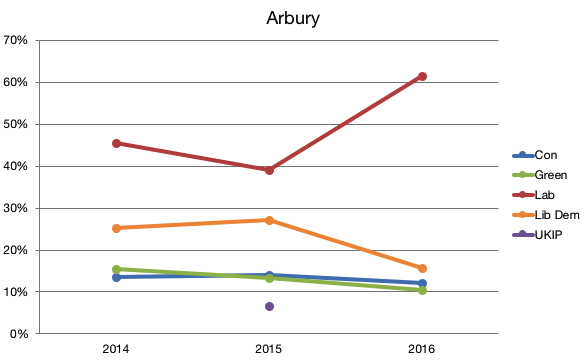
Arbury also looks like a safe Labour seat on the basis of recent City Council results, though the Lib Dems performed somewhat more strongly on the different County Council boundaries last year. Labour’s candidate is the incumbent Patrick Sheil, web developer and Kierkegaard expert, who won the seat at a by-election last year. He faces veteran Lib Dem Tim Ward, who was Arbury City Councillor from 2000-2014; Green candidate Stephen Lawrence, making his 21st attempt to be elected in Cambridge; and Conservative Dylan Coll-Reed, a second-year Natural Sciences undergraduate at Trinity College and the current Chairman of Cambridge University Conservative Association. A Labour victory seems the most likely outcome.
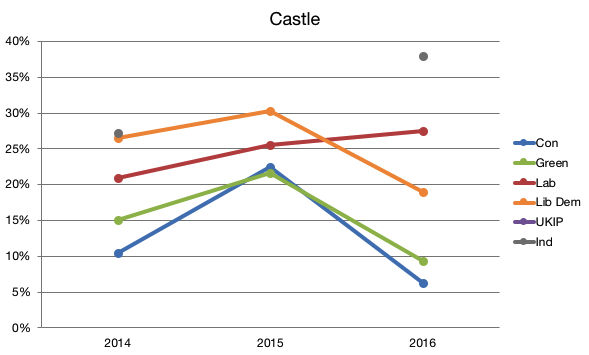
Castle offers one of the most intriguing prospects this year, as the incumbent Independent councillor, Marie-Louise Holland, is standing down. She won the seat in 2014 by just 20 votes, ahead of the Lib Dem candidate. This was rather a surprise to the Lib Dems, who had expected a larger Independent majority, and had consequently focused their efforts elsewhere. In 2015 there was no Independent candidate, and Lib Dem Valerie Holt took the seat reasonably comfortably. John Hipkin retained his City Council seat for the Independents in 2016, but narrowly lost the County seat to Labour last year, on rather different boundaries. With no Independent candidate this year, Castle is likely to be primarily a Lib Dem/Labour contest. Labour originally selected Baiju Varkey for the Castle seat, but he later switched to his home seat of East Chesterton. Labour’s candidate is now Mark Reader, who works in the Department of Land Economy at Cambridge University, and previously contested the seat in 2014. His Lib Dem opponent is Chesterton resident Cheney Payne, who is Head of Philosophy and Ethics at Thurston Community College near Bury St Edmunds. Lucas Ruzowitzky is the Green candidate, and the Conservatives are represented by Othman Cole, who is also standing for election in the Histon & Impington seat on South Cambs District Council. Completing the ballot paper is Aidan Powlesland of the Libertarian Party UK – as far as I can tell this is the first appearance of a Libertarian candidate in a Cambridgeshire election since Andrew Hunt contested Wisbech South in 2009. Mr Powlesland was previously a member of UKIP, and indeed contested UKIP’s 2017 leadership election, finishing last. During the recent General Election he attracted some press coverage with proposals to design an interstellar colony ship and mine the asteroid belt.
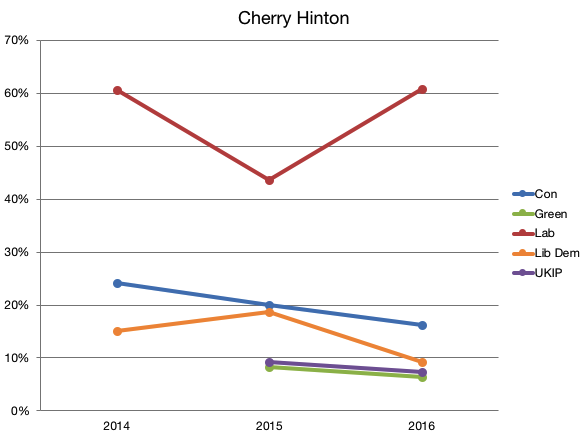
As in previous years, Cherry Hinton is likely to provide the least exciting contest in this year’s Cambridge local elections, as Labour’s Russ McPherson seeks a fifth term of office in this rock solid Labour seat. The main point of interest will be whether Conservative Eric Barrett-Payton, Lib Dem John Oakes, and Green candidate Jenny Richens maintain the usual order of runners-up. If Labour doesn’t win comfortably here, I will happily eat any sort of hat you care to present me with.
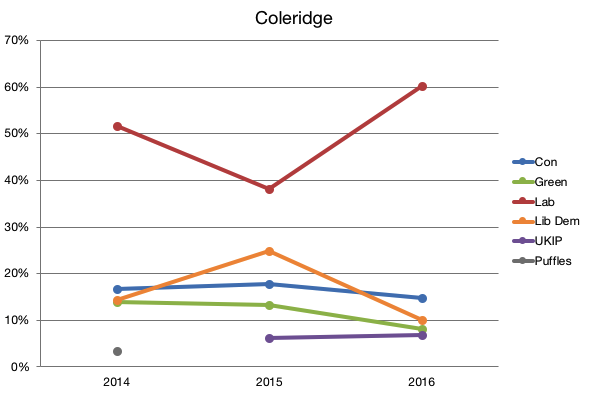
Another solid Labour win is likely in Coleridge, where Council leader Lewis Herbert is also seeking a fifth term. Two of Lewis’s opponents are newcomers; Lib Dem Noah Tate is a Content Manager at Cambridge University Press, and Green candidate Sarah Nicmanis is an Asset Management Administrator at the Hundred Houses Society. The Conservative candidate, Donald Douglas, is very far from being a newcomer – he represented Trumpington from 1998-2002. He is one of only five Conservative councillors elected in Cambridge in the last twenty years.
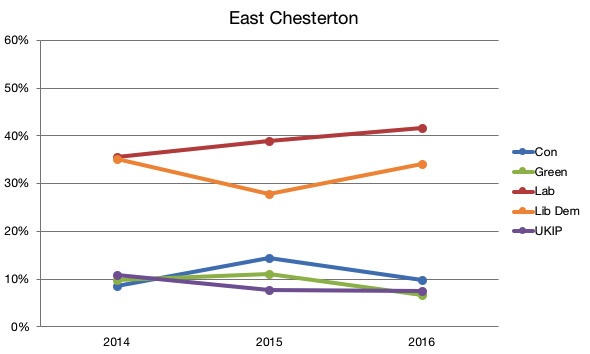
Four years ago East Chesterton provided a campaign that was…well, let’s just say, full of incident, and a knife-edge result in which Labour’s Peter Sarris edged out Lib Dem Zoe O’Connell by just ten votes. Peter Sarris is standing down this time, and his ward colleague Margery Abbott has resigned mid-way through her term, so two seats will be up for election. Consequently East Chesterton voters have no fewer than eight candidates to choose from. Labour’s candidates are Carla McQueen and Baiju Varkey. Carla McQueen runs a youth group for children with social communication difficulties together with Abbey Labour candidate Nicky Massey; Baiju Varkey is a trainee solicitor. The Lib Dem candidates are Owen Dunn, a Computer Officer at the University of Cambridge, and author Shahida Rahman, who has stood for election in East Chesterton twice before. The Conservatives are represented by Timur Coskun, a second-year student of English Literature at Trinity College, and Tom Harwood, a final year student at Durham University, who ran the Vote Leave national student wing. The Greens have a single candidate, Gareth Bailey, who stood in Castle last year, and the ballot paper is completed by UKIP’s Peter Burkinshaw, the sole representative of his party in this year’s Cambridge elections, who is justly famed for his unsympathetic responses to the Cambridge Cycling Campaign’s annual survey of local election candidates. A close Labour/Lib Dem contest seems likely, and a split result is entirely possible.
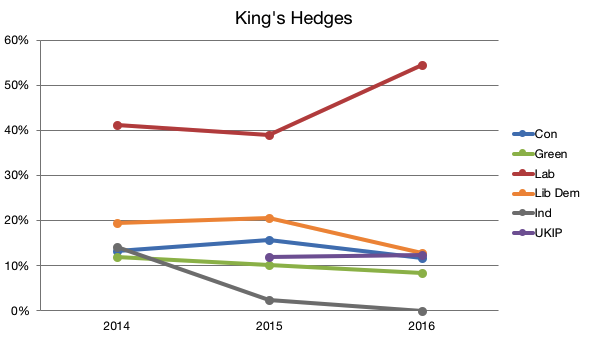
King’s Hedges is pretty safe for Labour these days, and the re-election of incumbent Martin Smart seems the most likely outcome. The Lib Dem candidate is Daniele Gibney, who is Diversity Officer for Cambridge Lib Dems, and King’s Hedges ballot paper regulars Anette Karimi and Angela Ditchfield appear for the Conservatives and Greens respectively.
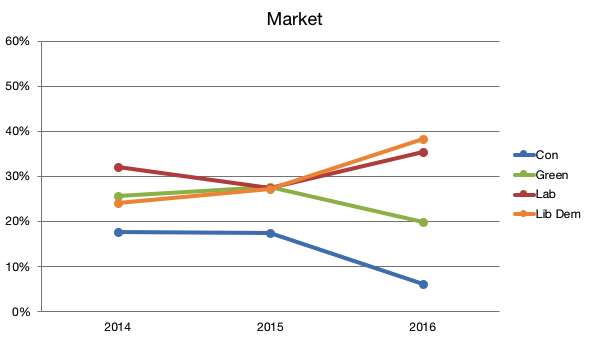
Market ward has seen some unexpected results in recent years. The incumbent, Dan Ratcliffe, won his seat in 2014 in a contest in which the Lib Dems had disowned their candidate following an assault charge, but Dan could well have taken the seat in any case. The following year saw a ridiculously close three-way split and the election of Cambridge’s only Green councillor, Oscar Gillespie, by just seven votes. Lib Dem group leader Tim Bick narrowly held on in 2016, and Nichola Harrison won more comfortably for the Lib Dems last year on the larger County seat boundaries. Market remains the best prospect in Cambridge for the Green Party, whose candidate Jeremy Caddick, the Dean of Emmanuel College, is standing for a second time. Nevertheless I think he is probably heading for third place again, and the main contest will be between Labour’s Dan Ratcliffe and Lib Dem newcomer Anthony Martinelli, an NHS doctor and former University Challenge winner. Showing the flag for the Conservatives is Henry Mitson, a student at Gonville & Caius college. The Lib Dems will be eyeing a possible gain here, but Labour could well hold on.
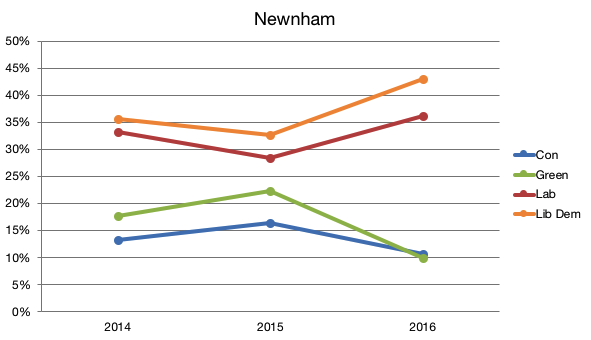
21 years ago at one of the first Cambridge election counts that I attended, Newnham Lib Dem candidate Elsa Meyland-Smith recorded the highest-ever number of votes in a Cambridge local election, 2,906. Things are rather different today, but despite narrower margins of victory, Newnham has continued to elect only Lib Dems in the intervening period. This is a record that is likely to continue this year, as the incumbent Rod Cantrill, recently selected as the next Lib Dem candidate for Cambridge MP, seeks re-election as a Newnham councillor. Labour’s candidate is Mike Davey, a retired County Council officer; Mark Slade, a musician and local entrepreneur is standing for a third time for the Greens, and the Conservative candidate is Connor MacDonald, a student at Emmanuel College.
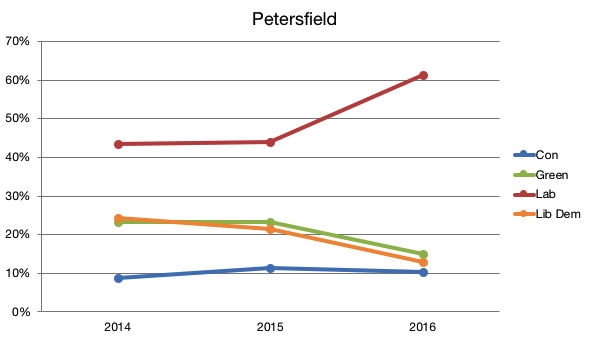
Petersfield sees a rematch between two of the candidates from the 2014 election, as Labour incumbent Ann Sinnott faces former Lib Dem councillor Sarah Brown. Army veteran Simon Lee is standing for the Conservatives, and Virgil Ierubino represents the Greens. Given recent electoral history, a Labour hold seems the most likely outcome.
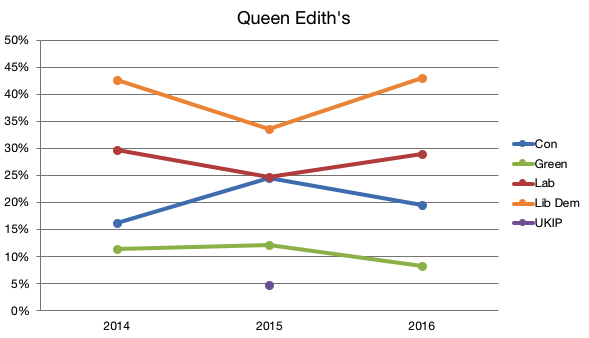
Queen Edith’s ought to be reasonably safe for the Lib Dems, but it’s not a certainty. With incumbent Tim Moore standing down, the Lib Dem candidate is newcomer Colin McGerty, an IT consultant who has previously been involved in campaigning in Abbey ward. Labour are fielding Dan Greef, who was their Parliamentary candidate for South Cambridgeshire in both the 2015 and 2017 General Elections, and is well-known in the area. Conservative Manas Deb is standing for a third time, and Joel Chalfen is making a sixth appearance for the Greens. A Lib Dem hold seems likely, but Labour could pull off a surprise victory as they did in 2012.
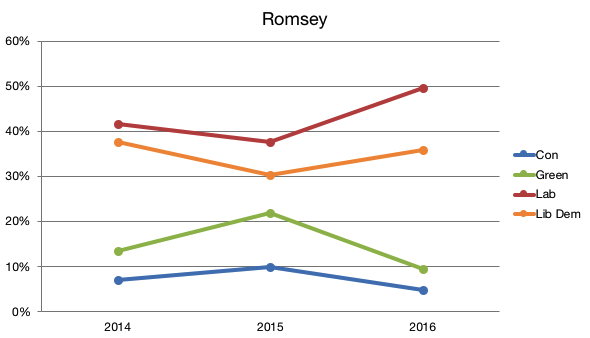
Once a Lib Dem stronghold, Romsey is now firmly back in Labour’s grip, with a well-organised and active campaigning operation. This year Labour’s candidate is former firefighter Dave Baigent, seeking re-election for the first time. His Lib Dem opponent is newcomer Joshua Blanchard Lewis, a languages tutor and former Vice-President of the Cambridge Union Society. Other candidates are Martin Keegan, Chairman of Cambridge Conservatives, and Caitlin Patterson, an NHS Staff Nurse, representing the Greens for a second time. I’m expecting a Labour hold with an increased majority.
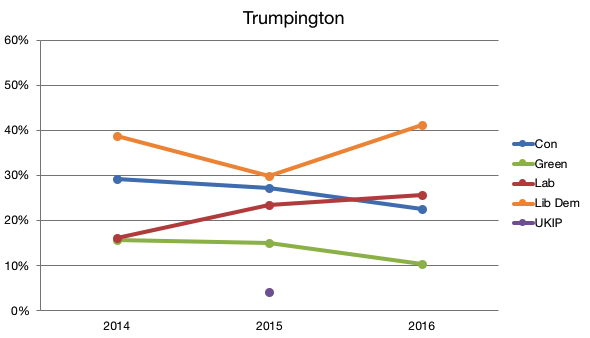
Trumpington should be reasonably safe for the Lib Dems, but Labour have now established themselves as the main challengers in a ward which had a Conservative councillor only two years ago. One of the factors changing the ward’s political makeup is the large amount of new housing being built; another is the increased level of Labour campaigning in recent years. Incumbent Lib Dem Nick Avery is standing down after a single term, and Daniel Hilken is hoping to succeed him for the yellow team. Labour’s candidate is architect Katie Thornburrow, standing in Trumpington for a second time. Phil Salway, a Senior Technician at Cambridge University, is the Conservative candidate, and Ceri Galloway, who has stood unsuccessfully for the Green Party 15 times in Trumpington, is back for a 16th attempt.
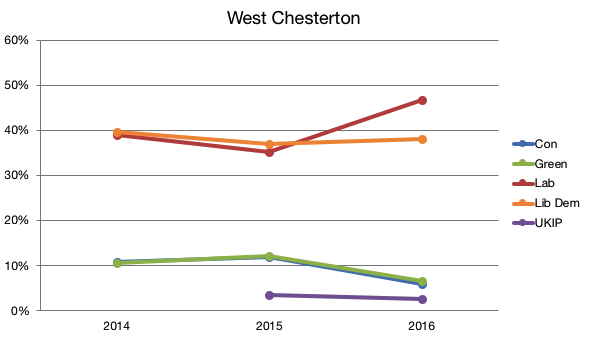
Finally, West Chesterton promises another closely-fought Labour-Lib Dem contest. Incumbent Lib Dem Ysanne Austin is standing down, and Jamie Dalzell is defending the seat from the challenge of Clare King, who will be hoping to make a gain for Labour. Clare was Lib Dem councillor for East Chesterton from 2007-2011 before switching to Labour in 2012, while Jamie has previously stood for the Lib Dems in Cherry Hinton and King’s Hedges – coming within 200 votes of victory in the latter seat last year. Shayne Mitchell makes a 16th attempt at being elected for the Greens, and Mike Harford, a retired marketing company manager, is standing for the Conservatives.
So what is the City Council likely to look like when the dust has settled? Excluding the seats being contested this year, Labour have 16 councillors, the Lib Dems 9, and there’s one Green and one Independent councillor. Amongst the seats that are up this time, I think Labour can be virtually certain of victory in six: Arbury, Cherry Hinton, Coleridge, King’s Hedges, Petersfield, and Romsey. Lib Dem victories are likely (though not guaranteed) in three: Newnham, Queen Edith’s, and Trumpington. That leaves six “battleground” seats: Abbey, Castle, East Chesterton (2 seats), Market, and West Chesterton. In each of these, only Labour or the Lib Dems have a realistic chance of winning – I’m expecting the grand total of Conservative, Green, UKIP and Libertarian victories in Cambridge this year to be zero. So overall I think Labour will end up with 22 to 28 councillors, the Lib Dems 12 to 18, and just one each for Green and Independent. With 42 councillors overall, this means that Labour will retain control, though if the Lib Dems perform at the upper end of expectations, we could be in for an interesting time next year, when Labour will have eight seats to defend and the Lib Dems just five. In 2020 we are likely to see all the City Council seats up for election at once following boundary changes, so things will certainly be interesting then.

Thank you Phil for a very clear and fair evaluation. Having been involved in election campaigns now for past 23 yrs. I fully agree with your conclusions. Abbey, W. Chesterton & E.Chesterton will be interesting watch for sure!
I have read your analysis and the bottom of my teacup and you are wrong as the leaves say Lib Dems are going to disappear into thin air because they don’t stand for anything. Poof – they’ve gone. People know the Labour Party are a force for good, and, Labour have a sense of humour 🙂
Pingback: Queen Edith's City Council Election Preview 2018